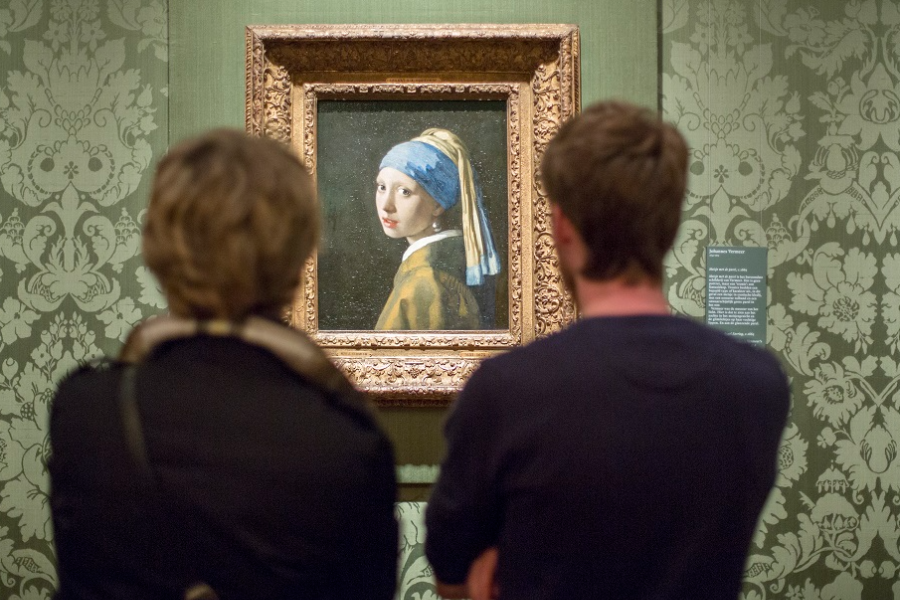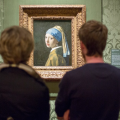Museum presenting one of the finest collections of Dutch paintings in an intimate setting in The Hague
The Mauritshuis is an excellent reason to visit The Hague. Located on the banks of the Hofvijver and the Binnenhof, it presents one of the finest collections of 17th-century Dutch paintings, in an exceptionally intimate setting. Completed in 1644, this beautiful classical-style building was designed by Jacob van Campen for Johan-Maurits de Nassau-Siegen. A great-nephew of William the Silent, Johan-Maurits was governor of Brazil, which gave the Mauritshuis its exotic touches that are still perceptible today.
In the entrance hall and near the stairs, a veritable gallery of Mauritshuis family portraits, its paintings pay tribute to the museum's founders and donors (Johan-Maurits de Nassau-Siegen, princes of the Orange family, stadhouders including William V...).
First floor: Flemish and foreign masters. On display here are a number of fine canvases by Flemish primitives (15th and early 16th centuries), including the Descent from the Cross (1463) by Brussels-based Rogier Van der Weyden, one of the undisputed masters of the Flemish Middle Ages and one of the first to introduce landscape and depict the donor in religious scenes that depart from academicism by dramatizing the composition. Also in the Van der Weyden room is a Portrait of a Man by Hans Memling. Influenced by Van der Weyden, Memling, a painter from Bruges in the second half of the 15th century, was one of the first to specialize in portraits of his city's bourgeoisie. Here, in the tradition of his master, the background is a landscape whose peacefulness contrasts with the concentrated expression on the face.
In the next room (the Boschaert room), although Flemish painters are still in the limelight with some fine still lifes, most of these are later masters (second half of the 16th century), who took refuge in Holland after the fall of Antwerp. Next is the Salon Doré, decorated in 1718 by the Venetian Pellegrini in a neo-Renaissance style.
The first Salle des Flamands houses works by Petrus-Paulus Rubens, the Antwerp master who succeeded in synthesizing the various major currents of his time to produce a truly universal painting in all genres (portraits, mythological paintings, still lifes, landscapes, religious scenes...). In this room, also known as the Rubens Room, you'll see an oil sketch in preparation for the famous altarpiece for Antwerp Cathedral: Assumption of the Virgin by Jacob Jordaens. Jordaens was one of the artists who introduced Caravaggio's techniques to the Netherlands, revolutionizing the use of chiaroscuro, so fundamental to the emergence of truly Dutch painting.
In the second Flemish room, the painting Adam and Eve in Paradise is by Rubens and Jan Bruegel, known as de Velours (the figures are by Rubens, the landscape and animals by Bruegel). Also on display are works by Antoine Van Dyck, another great Flemish master of the first half of the 17th century, particularly brilliant in his rendering of materials and drapery.
This room also features a little gem by Willem Van Hecht: L'Atelier d'Apelle. This painting creates a mise en abîme of representation, redoubled by the presence of a multiplicity of paintings in the background, including works by Rubens, Van Dyck, Quentin Metsys and Titian.
Second floor: Masters of the Dutch Golden Age. Here you'll find some of the finest paintings by the Dutch masters, starting with La Chasse aux poux and La Jeune Fille écrivant (Vermeer room), by Gerard ter Borch, the great genre painter of the mid-17th century, now somewhat overshadowed by his great contemporary Johannes Vermeer. In addition to an early work on a mythological theme, a room devoted to the latter presents two of his greatest masterpieces: The Girl with the Pearl and View of Delft. The former is unquestionably one of the most beautiful portraits ever painted. All its elements (the combination of blues, yellows and ochres; the fine, full features of a face that is both feminine and adolescent; the soft, steady gaze that nothing seems able to darken...) contribute to the harmonious expression of boundless tenderness. As for the View of Delft, that incomparable canvas with its incomparable, unsettling luminosity, which inspired numerous commentaries (including some magnificent pages by Proust, in À la recherche du temps perdu), it represents more a moment in the city than a view in the strict sense of the word: its cold morning light falls on a city that still seems to be asleep, giving off a muted harmony of pale tones that are only enhanced by a few touches of bright color, including the famous tiny yellow wall. In this room, you'll also find a church interior by Emmanuel de Witte, the undisputed master of architectural painting. Genre painting, already very well represented, takes center stage in the next room, with nine canvases by Jan Steen (1626-1679), remarkable for his depictions of picturesque popular scenes: Vie de l'homme, Comme les vieux chantent, piaillent les jeunes, La Joyeuse Compagnie, La Mangeuse d'huîtres..., paintings in which realism is redeemed by a sense of humor and tenderness for these simple existences. Fans of Donna Tartt will not want to miss Carel Fabritius's sublime Goldfinch in the same room.
Here we find four superb Frans Hals works, including the Head of a Young Boy, particularly characteristic of the master's lively art (Jan Steen room and Staircase room), a very fine Pieter Codde and several Rembrandts, including the superb Portrait of an Old Man. The next four rooms (the early 17th-century cabinet, the Potter room, the late 17th-century cabinet and the Staircase room at the end of the tour) offer an interesting panorama of the richness and thematic diversity of Dutch painting, whether in landscapes (particularly by Simon Van Ruysdael and Jan Van Goyen, two of the masters of the genre), still lifes or religious scenes. Paulus Potter's famous bull, dating from 1647, is impressive both for its size and for its attention to detail, such as the tiny frog in the foreground.
This is followed by two rooms devoted to Rembrandt. The first shows his early works, including Professor Tulp's famous Anatomy Lesson, in which the young painter brilliantly demonstrates that the collective portrait need not be frozen to be faithful. The second room contains canvases from Rembrandt's mature period, and shows how he progressively moved away from attention to detail and sought expression and dramatic tension through thicker, almost impastoed matter and a broad brushstroke, as in the sublime Saul and David, or the Two Negroes, probably the first portrait of black people in the history of Western art, or the Self-Portrait with Turban, a work from the year of his death, whose workmanship contrasts particularly with that of the previous room.
Mauritshuis has become the world's first fully pixelated museum. On the website, you can take an incredible tour, though it's no substitute for a "real" visit.
The museum organizes regular, high-profile temporary exhibitions. There's also a restoration workshop in the attic. A plunge into a little-known world that keeps the museum at an exceptional level, with its works constantly preserved. A few years ago, the museum made headlines with its live, public study of its star painting La Jeune Fille à la perle. Since then, other museums have followed suit, conscious of this unique public spectacle. Most recently, the museum naturally lent Vermeer's paintings to the Rijksmuseum's exhibition of the century.
Please note: the ticket also gives access to the superb Willem V Gallery and, as of September 1, 2024, it is no longer possible to pay cash for admission. Don't forget your card!
Did you know? This review was written by our professional authors.
Members' reviews on MAURITSHUIS
The ratings and reviews below reflect the subjective opinions of members and not the opinion of The Little Witty.












